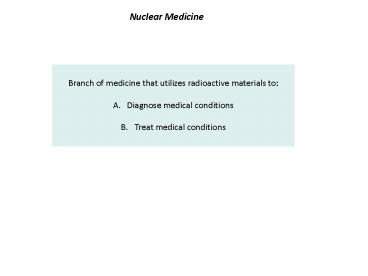Nuclear Medicine - PowerPoint PPT Presentation
1 / 13
Title:
Nuclear Medicine
Description:
Bone Scan of Prostate Cancer Patient Reveals Bone Metastases ' ... MDP bone scan depicts metabolic activity (x-rays, CAT scans: anatomy and structure) ... – PowerPoint PPT presentation
Number of Views:66
Avg rating:3.0/5.0
Title: Nuclear Medicine
1
Nuclear Medicine
- Branch of medicine that utilizes radioactive
materials to - Diagnose medical conditions
- Treat medical conditions
2
Nuclear Medicine
- Branch of medicine that utilizes radioactive
materials to - Diagnose medical conditions
- Treat medical conditions
3
Diagnostic Nuclear Medicine Relies on Gamma
Radiation
Injection or ingestion of g-ray emitter into
patient e.g. 99mTc, 131I, 201Tl
Detection of g-radiation
Why g-radiation for imaging instead of a- or
b-radiation?
4
Bone Scan Using Technetium-99m
Can detect cancer, fractures not visible on
x-ray, or damage from infection or illness
- 1) Inject Tc-99m MDP into patient
- Bone absorbs Tc-99m MDP to a greater extent where
there is injury, infection, or cancer (higher
metabolic activity) - Tc-99m emits g-radiation
- Detect higher levels of g-radiation where
abnormality is located
Tc-99m MDP Absorbed by bone Bone mineral
calcium hydroxyapatite Ca5(PO4)3(OH)
t1/2 6 h
(MDP methylene diphosphonate)
5
Bone Scan of Prostate Cancer Patient Reveals Bone
Metastases
Hot spot in bladder due to Tc-99m MDP tracer
excretion via urine
Tc-99m MDP bone scan depicts metabolic activity
(x-rays, CAT scans anatomy and structure)
http//www.hkma.org/english/cme/onlinecme/cme20021
1main.htm
6
Positron Emission Tomography (PET)
Carbon-11, oxygen-15, nitrogen-13, fluorine-18
emit positrons and are used in PET
18F 18O b
positron
t1/2 109 min
e-
electron
2 g
gamma rays
- PET radioisotopes emit positrons
- Positrons collide with electrons to form gamma
rays (annihilation) - The gamma rays are detected
7
Positron Emission Tomography Using 18F-FDG
- Inject 18F-fluorodeoxyglucose (18F-FDG) in
patient - 18F-FDG is a radiolabeled glucose analog
- 18F-FDG accumulates in regions of high metabolic
activity - (glucose energy source)
- a. Brain
- b. Heart
- c. Liver
- b. Cancer cells
- Detect gamma radiation where 18F-FDG is taken up
PET depicts metabolic activity
8
18F-FDG PET Depicts Metabolic Activity
Hot spots - regions of high glucose
uptake Applications Oncology Diagnose
tumors, measure response to therapy Neurology
Image brain for Alzheimers, epilepsy,
stroke Cardiology Assess blood flow, tissue
damage to heart
http//www.uthscsa.edu/mission/article.asp?id43
9
Nuclear Medicine
- Branch of medicine that utilizes radioactive
materials to - Diagnose medical conditions
- Treat medical conditions
10
Radiation Therapy for Cancer External Radiation
Source
Radiation damages DNA and interferes with cell
division. Since cancer cells undergo rapid
proliferation, they are more sensitive to
radiation than normal cells. Cobalt-60 is an
external gamma radiation source 60Co 60Ni
b- g t1/2 5 years b- radiation is
blocked g-radiation administered to
patient Why is a 5 year half-life OK for
this application?
11
Radiation Therapy for Cancer Internal
Administration of Radioisotopes
- -Radiation high energy electrons penetrate
tissue in small, localized regions.
Phosphorus-32 administered intravenously for
leukemia (NaH232PO4)
Iridium-192 implants for breast cancer
t1/2 74 d
t1/2 14 d
What is the advantage of a radioisotope implant
versus IV?
12
Iodine-131 for Thyroid Disorders
Normal thyroid
NaI from diet (iodized salt)
Thyroid hormone thyroxine
Treatment for hyperthyroidism or thyroid cancer
Na131I
Radioactive thyroxine kills thyroid cells
Iodine-131 is more localized in the thyroid gland
the radiotherapy target
13
Selection of Radioactive Isotopes for Nuclear
Medicine
- Radioisotope containing molecule must be taken up
by the target organ - Radioisotope containing molecule should have
different affinity for normal and diseased tissue
(diagnose abnormalities or target cancer cells) - Radioisotope should have appropriate half-life
- Radioisotope must undergo appropriate type of
decay































